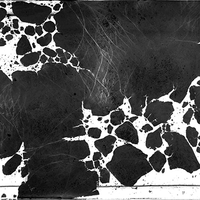When particles of a few tens of microns are spread on the surface of water, they aggregate under the action of capillary forces and form a thin floating membrane, a particle raft. In a tank with a raft made of graphite powder, we generate in the laboratory gravity surface waves, whose wavelength about 17 cm is very large compared to the thickness of the raft of order . For a sufficiently strong wave amplitude, the raft breaks up progressively by developing cracks and producing fragments whose sizes decrease on a timescale long compared to the period of the wave. We characterize the breaking mechanisms. Then we investigate the area distribution of the fragments produced during the fragmentation process. The visual appearance of the fragments distributed in size and surrounded by open water bears a notable resemblance to the floes produced by the fracturing of sea ice by waves in the polar oceans. Fragmentation concepts and morphological tools built for sea ice floes can be applied to our macroscopic analog, on which the entire dynamic evolution is accessible. However, the mechanics of the two systems differ, as our particle raft breaks due to the viscous stresses, whereas the sea ice fractures due to its bending by the waves.
- Received 16 October 2023
- Accepted 23 July 2024
DOI:https://doi.org/10.1103/PhysRevFluids.9.094302
©2024 American Physical Society
Fluid DynamicsPolymers & Soft Matter




Add Comment